#forever thinking about how nell was doomed from the start
Text





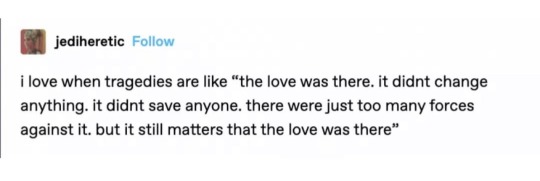
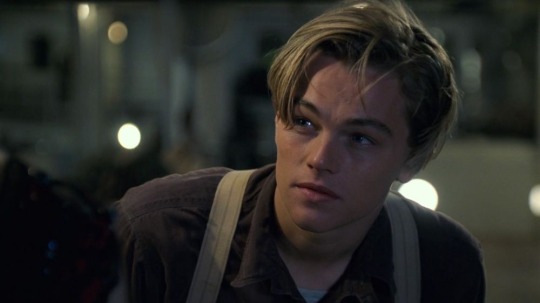



- doomed by the narrative
richard siken/ goodbye kiss- lana del rey/ revenge of the sith novel/ the haunting of hill house/ richard siken/ @jediheretic/ titanic (1997)/ exile- taylor swift/ aeschylus/ the haunting fate of eleanor crain: a character analysis of the haunting of hill house
#oh nell#forever thinking about how nell was doomed from the start#new webweave 🫶#webweave#web weave#webweaving#web weaving#parallels#the haunting of hill house#eleanor crain#titanic#taylor swift#lana del rey
398 notes
·
View notes
Text
The Princess Bride
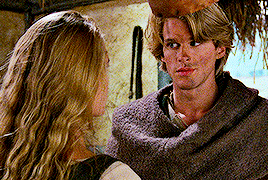
It feels downright inconceivableI to devote only one chapter in a book about lessons gleaned from eighties movies to The Princess Bride. Why, just off the top of my head, while standing on my head, I can name five life lessons that this movie teaches you that you don’t learn anywhere else: 1. “Never go against a Sicilian when DEATH is on the line!” 2. “Love is the greatest thing—except for a nice mutton, lettuce, and toma- to sandwich when the mutton is nice and lean.” 3. “Life is pain. Anyone who says differently is selling something.” 4. Eventually, you learn not to mind the kissing parts. 5. And most important, “As you wish” = “I love you.” Such is the depth of wisdom in this film that in 2013, twenty-six years after its release, BuzzFeed devoted a listII to the lessons gleaned from it. A BuzzFeed list! Who needs the Oscars, Princess Bride, when you have that ultimate of mod- ern-day accolades? The Princess Bride is so adored that it’s probablyIII now a clichéd response on Internet dating websites: walks on the beach, an open fire, sunsets, and The Princess Bride. And yet, despite this, love for The Princess Bride is not seen as desperately hackneyed or cheesily safe. The Princess Bride is what you’d need a prospective love interest to cite as their favorite movie for the relationship to progress,IV it’s the one film that would make you rethink a lifelong friendship if you found out your best friend “just didn’t get it”—not that they would ever say that, because I honestly don’t know a single person of my generation who isn’t obsessed with this film.
And not just my generation: in As You Wish, a very enjoyable book about the making of The Princess Bride, Cary Elwes—who played Westley the farm boy, of course—recounts being told by both Pope John Paul II and Bill Clinton how much they loved the movie, proving that The Princess Bride appeals to saints and sinners alike.V Now, having said all that, I have a confession to make. I was not the big Princess Bride fan in my family when I was growing up. That title instead went to my sister, Nell. Our mother took us to see it at the movie theater when I must have been nine and Nell was seven, and even though the film was— incredibly—something of a commercial disappointment when it came out, the cinema was absolutely packed with kids like us. In my mind, everyone in the audience was utterly in thrall to this tale of Buttercup (Robin Wright), her true love Westley (Elwes), and their battles against Prince Humperdinck (Chris Sarandon), Vizzini (Wallace Shawn), and Count Rugen (Christopher Guest), and their eventual assistance from the brave swordsman Inigo (Mandy Patinkin), the giant Fezzik (the professional wrestler known as André the Giant), and Miracle Max (Billy Crystal). Afterward, we stood in the cinema atrium as our mother bundled us back into our coats. “Did you girls like it?” she asked. Standing there in her corduroy dungarees and T-shirt, Nell looked in a state of semi-shock. “I LOVED IT. I WANT TO SEE IT AGAIN RIGHT NOW!” she practically shouted. Now, The Princess Bride is wonderful, but in order to understand how unex- pected this proclamation was, you have to know a little bit about my sister. Ever since she was old enough to throw a tantrum, my sister refused to wear dresses. She never played with dolls. She refused to let my mother brush her
hair and had apparently no interest in her physical appearance. She did not like mushy stories—she didn’t even like reading books. In other words, she was the complete opposite to me. How much of that was a deliberate reaction against me, a younger sibling defining herself in opposition to the older one, and how much of it was simply an innate part of Nell was already a moot point when we went to see The Princess Bride: Nell’s parameters were so firmly set by then that her nickname in our family was “the tough customer.” She would consent to drink only one kind of fruit juice (apple), and buy only one brand (Red Cheek), and only if it came out of a can (never a carton), so there was absolutely no negotiating with her about mushy princesses. Lord only knows how my mother got her to see the movie in the first place. She must have hid- den the title from her. And yet, like the grandson in the film, Kevin Arnold,VI Nell found that, against all odds, she did enjoy the story, just as Kevin’s grandfather, Columbo,VII promises. I think Nell made my mother take her to see the film at the cinema at least three more times. As she wished. When it came out on VHS, we bought it immediately and it was understood that the videocassette was officially Nell’s, just as the videocassette for Ferris Bueller’s Day Off was officially mine. When she found out that the film had originally been a book by William Goldman, who also wrote the screenplay, she asked my amazed mother to buy that, too. Nell read it over and over until the pages fell out, so she stuck them back in and then read the book again. The Princess Bride was the book that taught her to like books, as much as the movie taught her to relax some of her other rules. She developed a lifelong crush on Westley and, not long after, she started wearing dresses, too. The reasons why Nell loved this film so much exemplify, I think, why it is universally adored in a way that, say, the vaguely similar and contemporary The Never-Ending Story is not. It’s a fairy tale for those who love fairy tales, but it’s also a self-aware spoof for those who don’t; it’s an adventure film for boys and—for once—girls, too, but without pandering to or excluding either; it’s got a plot for kids, dialogue for adults, and jokes for everyone; it’s a genre film and a satire of a genre film; it’s a very funny movie in which everybody is playing it straight; it’s smart and sweet and smart about its sweetness, but also sweet about its smarts. Unlike, say, Shrek, there are no jokes here for parents that go over the kids’ heads: all generations enjoy it on exactly the same level. It’s a movie that lets people who don’t like certain things like those things, while at the same time not betraying the original fans. But most of all, The Princess Bride is about one thing in particular: “The Princess Bride is a story about love,” says Cary Elwes. “So much happens in the movie—giants, fencing, kidnapping. But it’s really a film about love.” This might seem like a statement of the obvious, but it isn’t, actually. Yes, the film is ostensibly about the great true love between Buttercup and Westley, and their most perfect kiss that leaves all the other kisses in the world behind. Both Elwes and Wright were so astonishingly beautiful when they made the film that, watching them, it’s hard to believe any love ever existed on this plan- et other than theirs. And they, rather pleasingly, were quite taken with one an- other. In his book, Elwes talks at length about how “smitten” he was with Wright, and she says precisely the same about him: “I was absolutely smitten with Cary. So obviously that helped with our onscreen chemistry. . . . It doesn’t matter how many years go by, I will love Cary forever.” Disappointingly, however, Elwes insists that they remained just friends. “Everyone asks if there was more!” he says, sounding a little exasperated, apparently unable to see what everyone else can: namely, that it seems against the laws of nature for two such beautiful people not to have had sex at least once. The last scene that Elwes shot was of him and Wright kissing on horse- back, creating “the most perfect kiss” of all time against a sunset. Surely that was romantic. “Well, not really. Robin and I were friends by that point so we kept laughing,
and [the director] Rob [Reiner] was going, ‘Touch her face, touch her face!’ ” He laughs. But Westley and Buttercup’s love is only a part of the film, and only one of several love stories in the film. There is also, for a start, the great love between Inigo and Fezzik. The scene in which a drunken and broken Inigo looks up into Fezzik’s face in the Thieves Forest and Fezzik says a simple, smiling hello is much more moving than the moment when Buttercup realizes the Dread Pirate Roberts is actually Westley (not least because she’s just pushed him down a hill). Even if Inigo does become the Dread Pirate Roberts at the end of the film, as Westley suggests he should, it is as impossible to imagine him going off without Fezzik as it is to imagine Buttercup and Westley being severed. This love between the two men is at the root of one of the film’s subtlest lessons. Bad guys teach audiences how to think of opponents in life, and this is especially true of bad guys in books and films aimed at kids. Because stories for kids tend to be relatively simple, villains in these films are almost invariably evil, and that’s all there is to be said about them. Cruella de Vil, Snow White’s stepmother, the witch in Rapunzel: WHAT a bunch of moody bitches. This is also certainly true of movies for children in the 1980s, from the frankly terri- fying Judge Doom (Christopher Lloyd) in Who Framed Roger Rabbit to the enjoyably evil Ursula in The Little Mermaid. It’s a pleasingly basic approach, and one that validates most kids’ (and adults’) view of the world: “I am good and anyone who thwarts me is wicked and there is no point in trying to think about things from their point of view because they have no inner life of their own beyond pure evil and a desire to impede me.” The Princess Bride, however, does something different. It’s easy to forget this once you’ve seen the movie and fallen in love with the characters but Inigo and Fezzik are, ostensibly, bad guys. When we first meet them in the movie, they knock our heroine, Buttercup, unconscious and kidnap her for Vizzini. We are also told they will kill her. Our princess! In the eyes of children, you can’t get much more evil than that. They are hired guns in the re- venge business, which is not a job for a good guy in any fairy tale. But Gold- man flips it around. We quickly see Inigo and, in particular, Fezzik being ex- tremely sweet with each other, doing their little rhymes together and trying to protect one another from Vizzini’s ire. Their love for one another shows us there is more to these villains than villainy. Goldman then ups the ante even further by having Inigo describe to the Man in Black how he has devoted his life to avenging the death of his father, thus giving him the kind of emotional backstory kids can definitely understand, as well as adding another mission to the movie. Soon after beating (but not killing) Inigo, the Man in Black fights with Fezzik, who we already know has a similarly sad past (“unemployed—IN GREENLAND”). Plenty of villains were once good before crossing to the dark side: Darth Vader, many of Batman’s nemeses, Voldemort. The point in those stories is that the difference between true evil and true greatness comes down to one wrong decision, one wrong turn, and there is no going back from that. But The Princess Bride does something more subtle: it suggests that good people some- times end up doing bad things, but are still good, have stories of their own, and are capable of love. Inigo and Fezzik both killed people in the past for Vizzini, but they’re all still good people. This is quite a message for kids (and adults) to take in: not everything is clear-cut when it comes to good and bad, even in fairy tales. In the original novel, William Goldman goes into much greater detail about Fezzik and Inigo’s friendship, and this is one of the reasons why I—in all hon- esty—pre-fer the book to the film.VIII But the film alludes to it enough in order for audiences to understand the real bond between the men, and partly this happens through the script and partly through the actors, especially one actor in particular. At one point, Arnold Schwarzenegger was considered for the role of Fezzik, but, thank heavens, he was already too expensive by the time the film
finally started shooting. Where Schwarzenegger is all jarring rectangles and jut- ting jaw, André the Giant was all soft circles and goofy smiles. Where Schwarzenegger palpably punished himself to a superhuman extent to get the body he clearly wanted so badly, the man born André René Roussimoff suf- fered from gigantism due to acromegaly and had no choice about his size, just as Fezzik didn’t, much to the latter’s misery (“It’s not my fault being the big- gest and the strongest—I don’t even exercise”). It would be a patronizing cliché to say André was born to play Fezzik, but he was certainly more right for the role than Schwarzenegger. By the time he made The Princess Bride, André was seven feet, four inches and weighed more than 540 pounds. Easily the sweetest stories in Cary Elwes’s book come from the cast and crew’s memories of the wrestler, who died in 1993 at the age of forty-six, and this is not mere sentimentality. Quite a few of The Princess Bride’s cast have, sadly, since died, including Mel Smith, Peter Cook, and Peter Falk, but none of them prompts the same kind of fondness as that felt for André. “It’s safe to say that he was easily the most popular person on the movie,” Elwes writes. “Everyone just loved him.” Partly this is due to the extraordinary nature of the man. Robin Wright re- calls going out to a dinner with him where he ate “four or five entrees, three or four appetizers, a couple of baskets of bread, and then he’s like, I’m ready for seconds. And then desserts. I think he went through a case of wine and he wasn’t even tipsy.” But it was André’s innately gentle nature that made him so beloved. His “compassion and protective nature,” Elwes writes, helped Wallace Shawn over- come his almost paralyzing fear of heights when they were filming the climb up the Cliffs of Insanity. When Robin Wright felt chilly when filming outdoors, André would place one of his huge hands on top of Wright’s head. “She said it was like having a giant hot water bottle up there. It certainly did the trick; he didn’t even mess up her hair that much!” Elwes writes. When he died, William Goldman wrote his obituary in New York magazine. The last lines were as fol- lows: “André once said to Billy Crystal, ‘We do not live long, the big and the small.’ Alas.” Next, on a smaller level, is the love between Miracle Max (Crystal) and his aged wife, Valerie (Carol Kane). Initially they seem simply like a squabbling old couple, playing purely for broad comedy (and their scene is the broadest comedic one in the film). But it soon becomes clear that Valerie is needling Max only because she wants him to get back his confidence in his work after Prince Humperdinck destroyed it by sacking them, and her little cheer when her husband agrees to make a miracle for Inigo is really very touching. By the end of their scene, they’re working together, finishing one another’s sentences, holding each other arm in arm, and whispering little asides to one another. As a portrait of elderly marriage goes, this one is a pretty lovely one. Finally, there’s the great love story that frames the whole movie: the one be- tween the grandson/Kevin Arnold (Fred Savage) and the grandfather/Columbo (Peter Falk). In the beginning of the movie, the grandson is irritated by his cheek-pinching grandfather and can hardly believe that he has to stop playing his adorably primitive-looking computer baseball game to listen to grandfather read a book.IX As the film progresses, the relationship between the grandson and grandfather progresses almost like a traditional love story: the grandson slowly gets more interested, clutching his covers anxiously when Buttercup is almost eaten by the Shrieking Eels; then he gets angry, banging his bed with his fist when it seems like Westley has been killed; and finally, he comes around entirely and tells his grandfather to come back the next day to read the book again. “As you wish.” His grandfather smiles, and the film ends. “That wasn’t actu- ally in the script,” Elwes says. “They came up with him saying that on, I think, the last day, and it really captures the love between the grandfather and grand- son. You can also see the tenderness between Fred Savage and Peter Falk.”
2 notes
·
View notes
Text
TATBT Recommends: 'The Haunting of Hill House,' AKA, Spooky 'Parenthood'
"Ghosts can be a lot of things: a memory, a daydream... but most times they're just what we want to see."
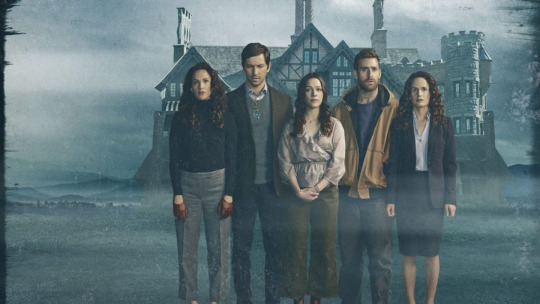
**This article originally appeared in the TATBT newsletter. No spoilers beyond the first episode!**
Steven Crain uses these words to undermine the idea of "real" ghosts in the earliest moments of this ghost story, immediately establishing himself as The Haunting of Hill House’s skeptical audience surrogate (although I trust that we are all much less of a drag than Steve, while simultaneously being just as hot as him).
Series creator Mike Flanagan then spends the next 10 episodes proving to us and to Steven, in the most frightening ways possible, that just because the ghosts of Hill House can be explained doesn't make them any less real — and no amount of logical explanation can rid Steven or his family of the ghosts that bind them together. Trauma is not logic-bound, and neither are the scars it leaves behind.
The Haunting of Hill House dropped on Netflix a week ago, and while I knew it would be an extremely loose adaptation of Shirley Jackson's fearsome 1959 gothic horror novel of the same name, I surely could not have guessed that the malleable nature of that adaptation would turn this haunted house story into what I've been referring to as...Spooky Parenthood.
And that’s a compliment. Prepare yourself for a gushing recommendation,; although I do discourage you from watching Hill House with the lights off, a full bladder, or in the near vicinity of anything that casts a shadow. The list of things that made me do a double-take, followed by a full 20-second stare down to see if they moved again include: the shadow of a sink faucet, every open door in my house, and the reflection of my own face in the TV when I finally turned Hill House off.
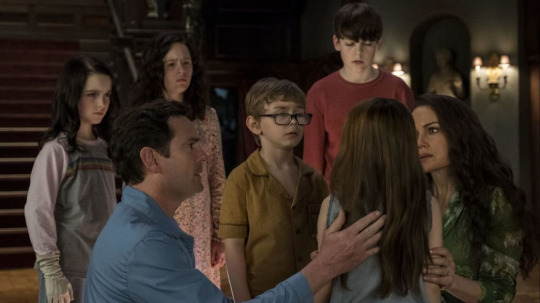
The Haunting of Hill House follows the Crain family at two different points in their lives: the summer when they briefly lived in a gorgeous, super haunted Victorian manor that was "born bad," and then 26 years later when a great tragedy forces them to reckon with the ways in which that house never left them, no matter how long ago they left it. The nonlinear nature of this family story might lend itself more glaringly to a This Is Us comparison, but the thing is...I'm the one making said comparison, and I think Parenthood is a far superior family drama to This Is Us.
And The Haunting of Hill House is, indeed, an excellent family drama. Who knew?! I love a good scare, especially around Halloween, so I set into Hill House expecting to do a little doom, make a little ghost, get scared tonight. All those things happened, but I also found myself crying repeatedly — a reaction to entertainment I both cherish and live in fear of. The cleverness of this series is that Flanagan understands that horror can be doubly horrifying when its rooted in care.
After getting to know the Crain family, you don't just want these people not to be tormented by ghosts because ghosts are the worst; you don't want them not to be tormented by ghosts because you care for them, in that same complicated way they care for each other in the midst of their own grief and tragedy.
The scares of Hill House aren’t just frightening...they’re sad. And surely there is nothing more frightening than despair. So the question remains: can you enjoy watching a series that asks you to repeatedly bare your second-hand soul in a sea of self-reflective human tears?

Parenthood and The Haunting of Hill House say yes you can, and you will probably love it all the more precisely because of that emotional connection.
With style and empathy, Hill House coaxes viewers into caring for a family who turn away from their shared trauma and mental health at every turn. It makes you care for them so hard, you won't even give up on them when those turns so often reveal floating men in bowler hats and long-haired ladies with disturbing 90-degree angles in their necks.
Because of that time spent cowering under beds and around corners with the terrorized younger Crains, you understand why older Luke would turn to drugs; why Shirley would build up walls so steep no one can get in; why Theo would give so much to her work and so little to herself; why Nell would find the allure of her mother's own mysterious demise irresistible in the wake of numbing personal tragedy; and why Steve...
Well, Steve is just kind of sanctimonious and rude, but he's an eldest child with a superiority complex, and when building a family drama, it's important to depict accurate family dynamics. We need look no further than Adam and Kristina Braverman to know that just because someone is annoying doesn't mean they're not bringing a necessary ingredient to the familial table.
Sorry oldest children. — signed, ME, an endlessly lovable youngest child; a more reliable Crosby, if you will.

Of course, the youngest child in this scenario is Nell, a touch on the unreliable side because at only 6-years-old when her parents moved her to Hill House, she and her twin Luke were most vulnerable the spectral happenings within. A child cannot use logic or happenstance to explain away what's right in front of them — they can only see what's there. It's no surprise that being told what’s right in front of you is actually all in your head could leave psychological scars so lasting they'd lead grown-up Nell to...
Well, you’ll see.
If you don't like horror or earnestness, there's a good chance you won't like The Haunting of Hill House. But if you like even one of those things, this weird hybrid of a series might just sway you into liking the other. To call it "fun" would not exactly be correct on account of all the oppressive grief and sorrow and whatnot. But it thrills in that way only a truly spooky story can, and the family at its center is so thoroughly engaging.
Undoubtedly, life is a far more difficult journey for the Crains than it was for the Bravermans, but I am here to tell you, the healing that awaits them at the end of this battle is worth the fights and frights, if you’re willing to take the trip with them.
Oh that's right — this show is scary as hell and it gets a (mostly) happy ending. A few other helpful things to know going in:
THE CASTING
I've said repeatedly that Flanagan takes his time establishing empathy for the Crain family through recognizable sibling dynamics, and familial grief and devotion, but there is one thing he employs that establishes connection immediately...

The Crains are all smokin’ gorgeous, starting with their parents played by Henry Thomas in a pair of spooky-but-whatever-I'm-into-it blue contacts and Carla Gugino who has been maybe the most beautiful woman in the world for like 20 years running. The woman does not age, she just spawns cute little versions of herself who grow up to be beautiful, haunted adult iterations of herself. And the only thing I like more than a group of unreasonably hot characters...
Is the perfect casting of miniature versions of those characters. Seriously, I know y'all like This Is Us, but eat your fucking heart out Mandy Moore's painted-on wrinkles. The kids in that show are cute and they bear a passing resemblance to their adult counterparts, sure, but look at this:
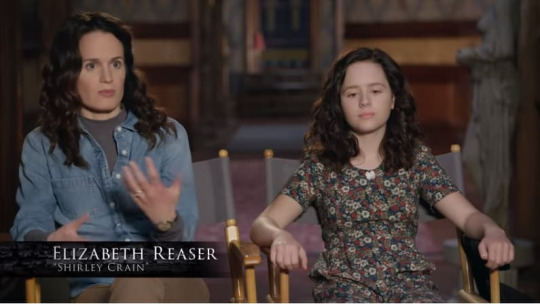
Elizabeth Reaser (grown-up Shirley) and Lulu Wilson (l'il Shirley and also Camille's ghost sister in Sharp Objects) look...exactly alike??? It is wild. And it just goes on from there...
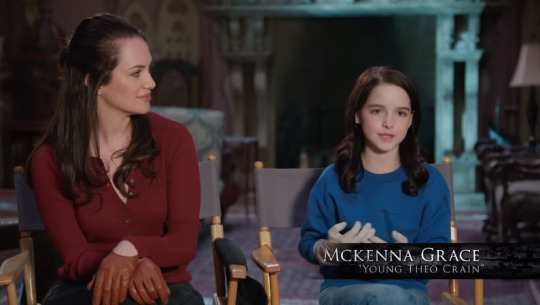
I've hardly even mentioned Theo, the coolest Crain sibling by far, played by the impossibly gorgeous Kate Siegel in full-size, and by the most prolific child actor of her generation, McKenna Grace, in fun-size.
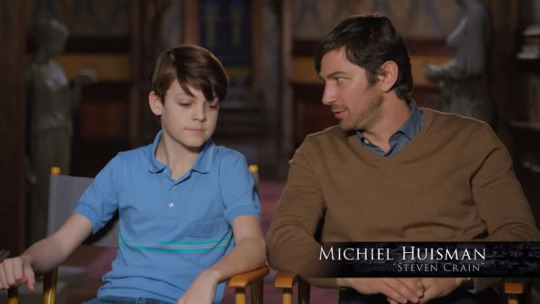
I have mentioned Steve, but it's worth noting that much of his insufferable adult characteristics are assuaged by the fact that his younger self (Paxton Singleton) is a highly endearing little preteen nugget, and his older self is played by hot ass Michiel Huisman pretending to be a nerd by always carrying around a pair of lucite-framed glasses, but never actually wearing them.

And, oh the twins; these poor, poor twins who have just the most adorable faces, you can almost understand how a ghost would want to get all up in there for a squeeze. Given all these Honey-I-Shrunk-the-Actor magic tricks, it could only be intentional that tiny bespectacled Luke (Julian Hilliard who must have Jacob Tremblay absolutely shaking) grows up to be Oliver Jackson-Cohen who could legitimately play Captain America post-experiment.

The camera spends a lot of its 10-hour run time zoomed-in on the face of little Nelly (Violet McCraw), so it's a delight every time you're struck once more by how much grown-up Nell (Victoria Pedretti) looks exactly like an enlarged version of her child self...even if every zoom of grown-up Nell is not a delight in and of itself.
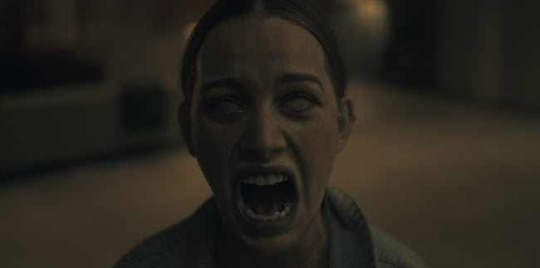
That’s from the first episode! It’s not a spoiler, really! You’ll just have to watch!
IT'S THE SUMMER OF 1992
The Mall of America is opening, Ross Perot thinks he should run for President, and the Crain family have just moved to Hill House with intentions of flipping it to make enough money for their "forever home." It's difficult to immediately tell what time period the Crains are in when they move into Hill House because Olivia, the warm but occasionally possessed Crain mother is prone to swanning around the drafty mansion in velvet robes and wedges.
So, sometimes you might feel like it's 1970, but knowing from the beginning that it's 1992 could be helpful to your viewing experience.
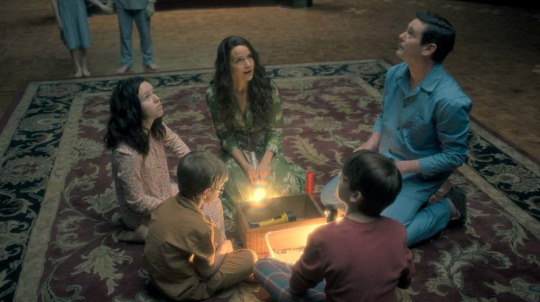
The present-day timeline is 26 years later, and this will make it all the more curious as to why they brought in Timothy Hutton to play a 26-years-later Henry Thomas when Timothy Hutton is only 10 years older than Henry Thomas, but...should I just show you the young-and-old Shirley comparison again, and what say we forget all about this misstep??
THIS IS EPISODIC TELEVISION
The first five episodes of Hill House are building blocks, each one told from a different Crain sibling's perspective. I don't normally like to say this because it can make a viewer hyper-aware of their own viewing experience, but you gotta stay vigilant when there are ghouls peeking out from every dark corner anyway, so here goes: Just give it a few episodes! You might not find yourself enthralled in the first one or two, but the build is so enjoyable along the way. Y'know, if you find secondhand suffering and personal terror enjoyable (I doooo).
And once you make it to episode 5 — Nell's episode — you might not shake it for days. I certainly would not recommend watching it right before bedtime or in any sort of rush. I can think of few other entertainment experiences so suspenseful and conclusive; so terrifying and moving all at once.
And that emotional climax makes the perfect entry point to the marathon that is episode 6, which plays out like a stage production in only five continuous shots, the longest one running 17 minutes straight.
youtube
And this is where I warn you that some people who have loved the series have not loved the final episode. I am not one of those people because I'm sappy as hell and I love a perfectly tied ribbon around an oozing, molding, rotten, terror-wrapped package.
No, the emotion-heavy resolution of Hill House is not subtle, but family resolutions rarely are. They take time, and work, and they cannot be passive. Deep wounds — cuts that have been kept open for a lifetime — must be healed with intention. The ghosts that have haunted the Crain family for decades haven't disappeared by the time the final credits roll, but acknowledging that they were ever there in the first place is comfort enough.

Get more recaps, recommendations, and rundowns from the These Are the Best Things newsletter -- your one-stop shop for pop culture!
SIGN UP FOR MORE TATBT RIGHT HERE!
#the haunting of hill house#haunting of hill house#theo crain#luke crain#nell crain#shirley crain#steve crain#hill house
28 notes
·
View notes
Text
i think there’s almost something really symbolic about how nell got the happy ending people with abuse histories often want - she found a knight in shining armor in which presence ghosts cower in, and married him, and everything looked like it was going to be perfect forever and ever and ever - and then her ghosts - literally herself - came back and destroyed that fantasy
now obviously nell didn’t do anything wrong. she looked for sleep therapy for what she thought was a sleep disorder, fell in love with this super handsome, gentle man that brought out the best in her and made her feel hopeful, he died and she couldn’t take his loss, and then she went back to the house to confront the house in a human, emotional way, and then the house killed her for it because it wanted her and her mother wanted her dead and by her side
but i just think it’s really neat how her relationship with arthur was doomed from the start in a symbolic way because you can’t expect other people to save you from your own ghosts
3 notes
·
View notes